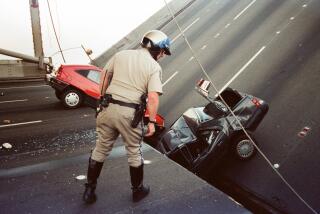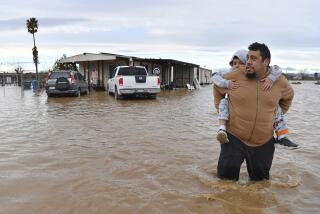Insurers Reevaluate Hurricane’s Losses
Hurricanes are never good news for insurance companies. But by veering east of New Orleans on Monday, Hurricane Katrina may have saved insurers a bundle.
Initial estimates of as much as $30 billion in insured losses were pared to between $9 billion and $25 billion by Monday evening as fears of a direct hit on New Orleans evaporated.
Insurers also have done a good job of mitigating their economic losses from natural disasters by passing some of the business on to re-insurers, said Anthony Diodato, a property and casualty insurance analyst with A.M. Best & Co. in Oldwick, N.J.
“The companies that are most affected are well capitalized,” Diodato said. “At this point, I don’t anticipate any long-term impact.”
Major casualty insurers saw only modest losses on Wall Street, with Allstate Corp. sliding 77 cents, or 1.3%, to $57.18 and St. Paul Travelers Cos. falling 47 cents, or 1.1%, to $44.27. The downturn was steeper early in the day, but the companies recovered later when Katrina was downgraded to a lesser storm.
Still, Katrina is expected to rank among the most costly hurricanes in history, likely to be exceeded only by Hurricane Andrew in 1992, which caused $15.5 billion in damage ($20.8 billion when adjusted for inflation).
But estimates of the cost of Katrina’s wrath ranged widely Monday, largely because insurance adjusters were unable to get into the storm-ravaged areas to assess the damage.
“We have no loss reports yet,” said Jeff Beyer, spokesman for Los Angeles-based Farmers Insurance Group, which is one of the biggest property insurers in Louisiana and Mississippi. “As of this morning, we had adjusters ready to move into Louisiana, but they haven’t been able to get on the ground yet.”
Risk Management Solutions of Newark, Calif., was estimating losses ranging from $10 billion to $25 billion.
Oakland-based Eqecat, meanwhile, downgraded its loss assessment to between $9 billion and $16 billion from as much as $30 billion previously. And Standard & Poor’s, which provides investment ratings on bonds issued by insurers operating in the Gulf states, said it expected losses of $12 billion to $15 billion.
Although the losses still are expected to be substantial, they are a fraction of what insurers were bracing for Sunday night when it looked as if the hurricane would touch ground in the heart of New Orleans.
The city is below sea level and is only dry under normal circumstances because of a system of pumps and levees that probably would be overwhelmed by a hurricane with Katrina’s intensity.
Instead, the storm veered east, hitting Biloxi and Gulfport, Miss., the hardest. The storm also began to lose steam by Monday afternoon.
Whatever the final tab, Californians don’t have to worry about higher insurance bills as a result.
“It is horrifying ... but it will not affect rates here,” said Bill Sirola, a spokesman for State Farm, which is among the largest insurers in both California and the hurricane-ravaged southeast.
“Rates are predicated on the states in which the policyholder is based because it wouldn’t be fair to ask people in Kansas to pay for California wild fires or for Californians to pay for Louisiana hurricanes,” he said.
*
(BEGIN TEXT OF INFOBOX)
Modest market fallout
Insurance companies’ stocks were not affected significantly by the hurricane. Here is a sample:
*--* Mon. Mon. Pctg. YTD pctg. Stock close change change change American Intl. $59.53 +$0.26 +0.4% -9.4% Chubb 87.12 +0.06 +0.1 +13.3 St. Paul 44.27 -0.47 -1.1 +19.4 Ace 44.51 -0.54 -1.2 +4.1 Allstate 57.18 -0.77 -1.3 +10.6 Hartford 73.63 -1.08 -1.5 +6.2
*--*
Source: Bloomberg News
More to Read
Inside the business of entertainment
The Wide Shot brings you news, analysis and insights on everything from streaming wars to production — and what it all means for the future.
You may occasionally receive promotional content from the Los Angeles Times.










